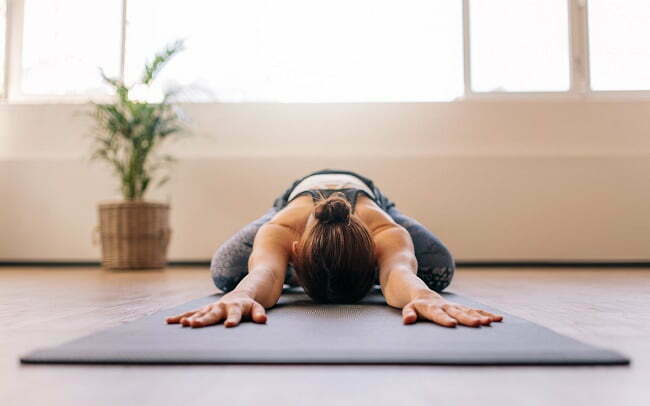You don’t have to learn the whole sun salutation sequence or engage in complicated contortions to practice yoga for sleep. You don’t even need to be particularly athletic or flexible.
“There is some suggestion that certain postures may be helpful,” says Johns Hopkins sleep expert Anastasia Rowland-Seymour, M.D. “But the benefits are more due to its meditative properties.
Many studies have linked yoga’s benefits to improved sleep, including recent findings by Johns Hopkins that showed better sleep among legally blind patients who participated in an eight-week yoga program.

Make Yoga for Sleep Work for You
Want to give yoga a try to improve your sleep? Here’s where to start.
Choose the right style of yoga for sleep.
Not all yoga is created equal, when it comes to relaxation, says Rowland-Seymour. Hot yoga and vinyasa (flow) styles tend to get your heart pumping. “You wouldn’t do these right before bed any more than you would run on the treadmill,” she says. Better styles for pre-sleep are hatha yoga (which focuses on body position) and nidra (which focuses on breathing and more restorative poses, such as lying and sitting postures).
Set the scene for sleep
Since it’s a good idea to reserve the bedroom for sleep and sex, Rowland-Seymour recommends doing your yoga poses for sleep in another room, if possible. Find a location where you can stretch out and also put your legs up against the wall. Dim the lights and turn on soothing music, if you like. Lay on carpeting, a yoga mat or something else padded, and keep some pillows handy to help you get comfortable in the poses. You may also want to change into loose-fitting pajamas or clothes that won’t restrict movement.
Focus on your breathing.
Breathing is one of the most important therapeutic aspects of yoga. Your goal during each session is to focus your attention on your breath, let all of your thoughts drift away and be present in the moment. Having trouble staying focused? Rowland-Seymour offers this exercise: Imagine yourself standing on the side of a highway watching the cars pass by. When you see a nice car, you wouldn’t think of trying to jump into it, she says. You’d just watch it pass. Try to do the same with your thoughts. Above all, practice self-compassion, says Rowland-Seymour. “Whatever your body is able to do is OK,” she says. Don’t judge yourself if your mind wanders or your muscles feel tight.
Source: Johns Hopkins

